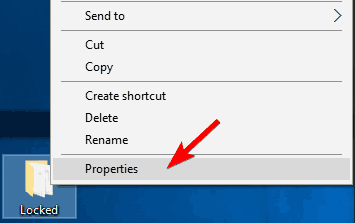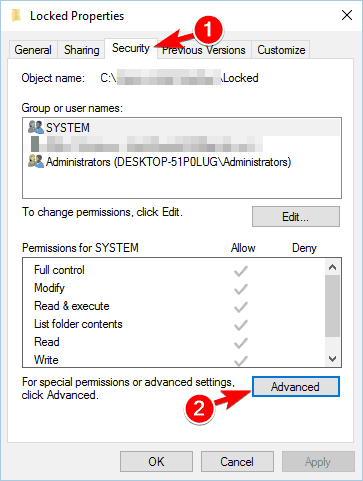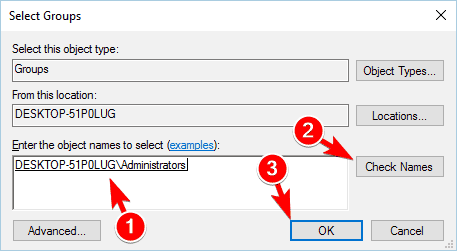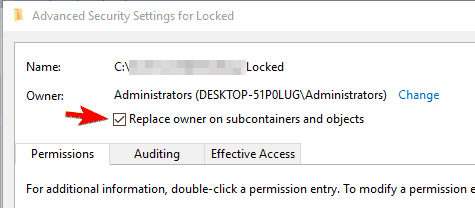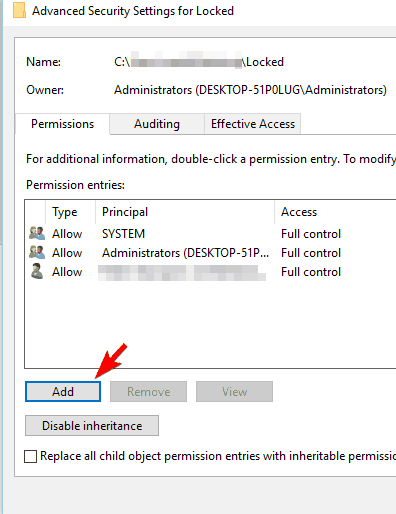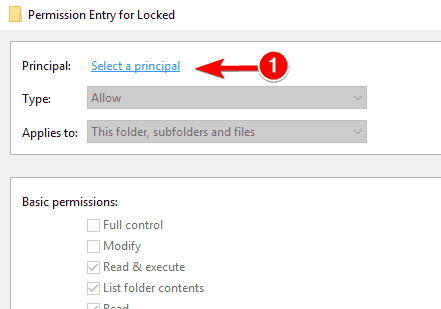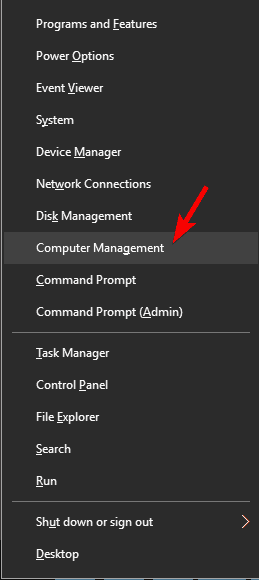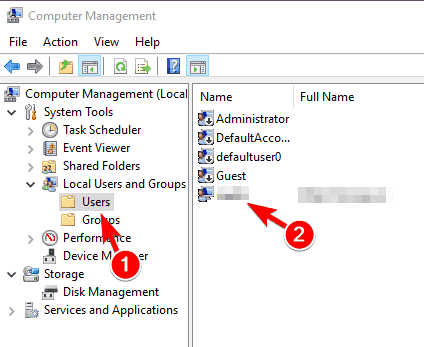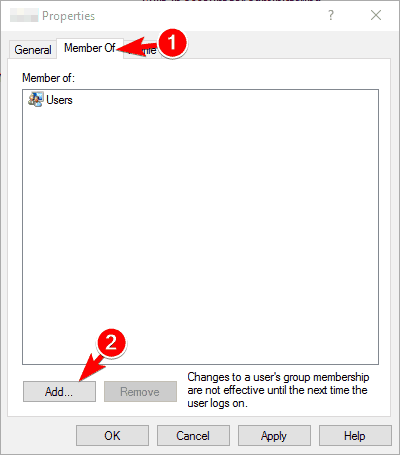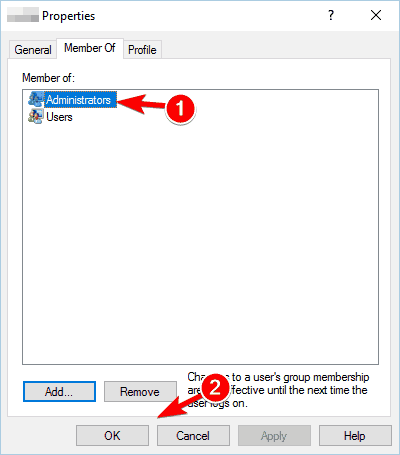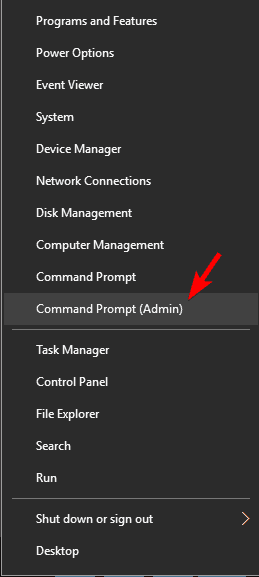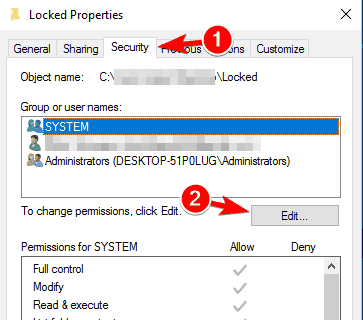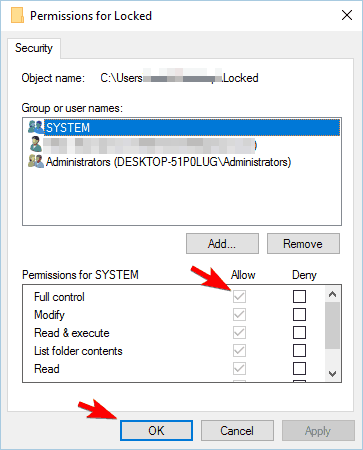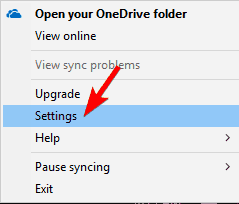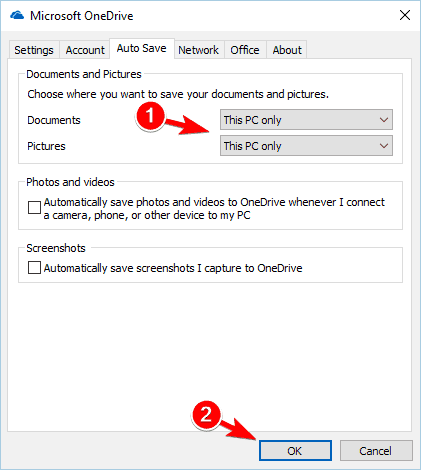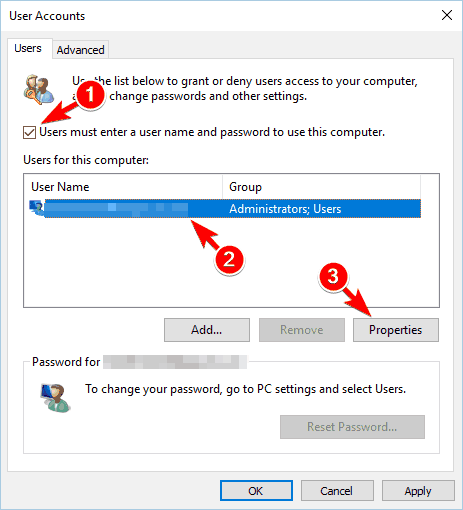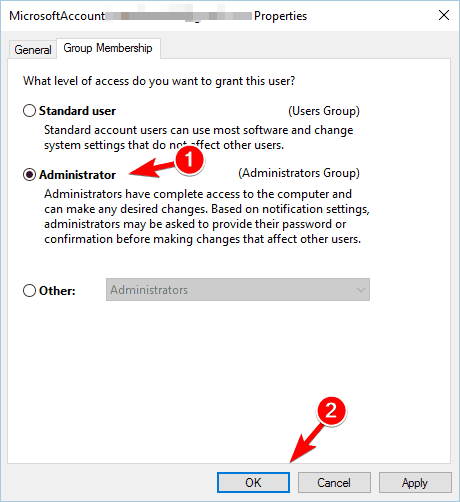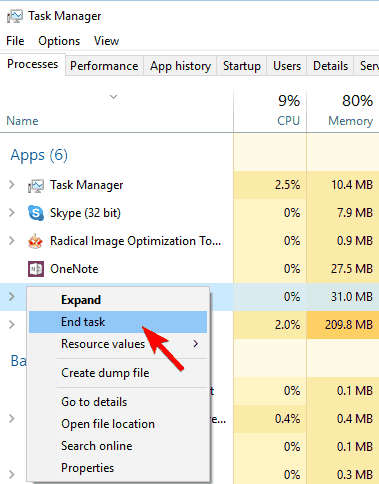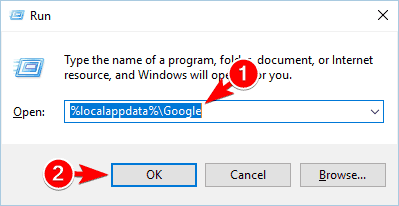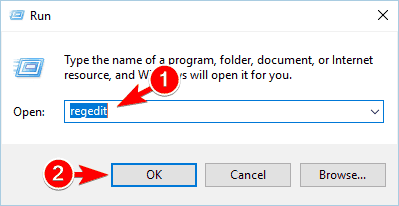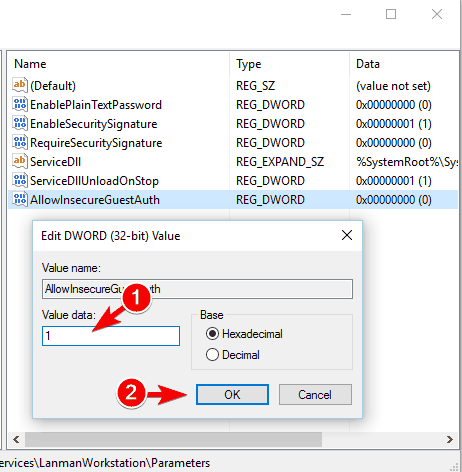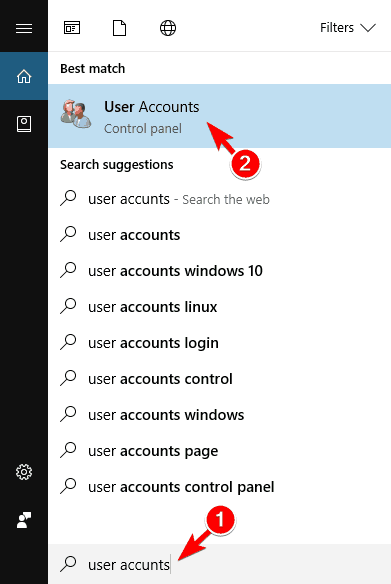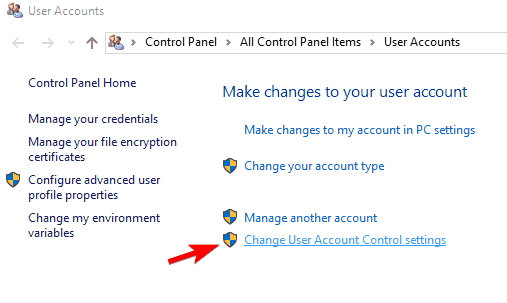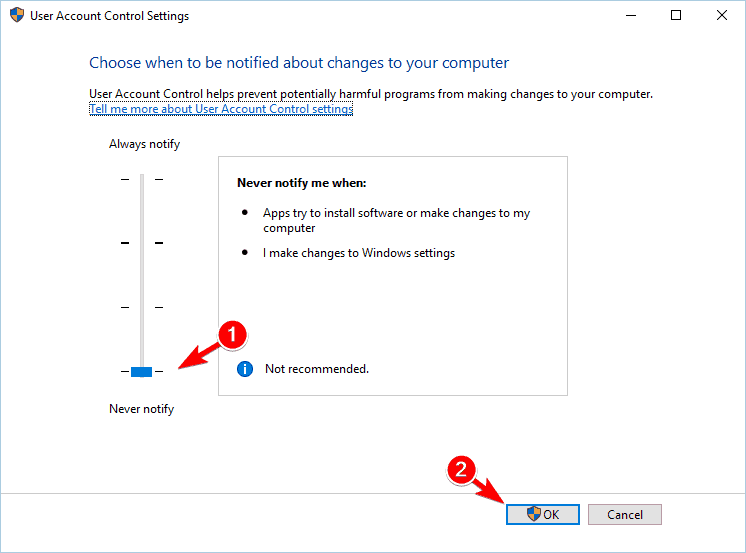- How to Fix Access Denied Folder/File Errors on Windows 10/8/7
- Method 1: Get the ownership of the file or folder
- Method 2: Get Permission of the File or Folder
- Method 3: Unencrypt File or Folder
- Method 4: Recover Corrupted File & Folder
- Access is denied Windows 10 error [FIX]
- How to fix Access is denied message on Windows 10?
- 1. Take ownership of the directory
- 2. Add your account to the Administrators group
- 3. Enable the hidden Administrator account
- 4. Check your permissions
- 5. Use Command Prompt to reset permissions
- 6. Set your account as administrator
- 7. Use Reset Permissions tool
- 8. Close Google Drive and reinstall it
- 9. Edit your registry
- 10. Turn off User Account Control
- 11. Disable your antivirus software
How to Fix Access Denied Folder/File Errors on Windows 10/8/7
«I am simply trying to delete a few unused folders. But I get the error that ‘Folder Access denied — Need to provide admin permission to delete this file’. I am the Administrator. Yet it won’t let me delete. «
It is annoying when Windows tells you are not allowed to access folders or files on your own PC. Fortunately, you are not the only one who has experienced «Access Denied» error on Windows 10/8/7. According to some users, Access Denied error usually appears after updating Windows system.
Why does «Access Denied» error appear?
The folder ownership has changed;
You don’t have the appropriate permissions;
The file may be encrypted;
The file may be corrupted.
To fix «Access Denied » folder or file errors, try out the following methods one by one until the problem is solved.
Method 1: Get the ownership of the file or folder
Sometimes, some of your account information might have changed when you’ve upgraded your Windows to the latest version. That’s why you lost your ownership of some folders and files and can’t access the folders or files. In this case, you should restore your ownership of the file or folder by following the steps below.
The steps to get the ownership of the file or folder are slightly different between Windows 10/8 and Windows 7.
Step 1. Right-click on the folder, and then, choose «Properties» on the menu.
Step 2. Click «Advanced» in «Security» tab. Click on «Change».
Step 3. Type the account name that you want to assign ownership to. Then click on «Check Names» button > «OK».
Step 4. If you want to give this account the ownership of the files and subfolders contained in this folder, enable the «Replace owner on subcontainers and objects» option. Click «OK»
For Windows 7:
Step 1. Right-click on the folder, and then, choose «Properties».
Step 2. Click on «Security» tab>»Advanced» button.
Step 3. Choose «Edit» in «Owner» tab to change the owner.
Step 4. Hit on «Other users or groups. » button to manually choose the username and type your account name.
Step 5. Next, click on «Check Names» button>»OK». Enable «Replace owner on subcontainers and objects» option, if you want to take the ownership of the files and subfolders.
Step 6. Click «OK».
Method 2: Get Permission of the File or Folder
As we know, permission is the basic factor for users to access files and folders on PC. If you do not have the appropriate permission, you can’t access or change files or folders. So if Windows denies your access to a certain file or folder, you get the permission of the file or folder in following steps.
First of all, you need to check permissions on a file or a folder. Here we’ll show you a simple tutorial below.
Step 1. Right-click on the folder and then hit «Properties».
Step 2. Select «Security» tab.
Step 3. Click on your name in «Group or user names» to check the permission that you have.
If you want to change the permissions on a file or a folder, you should log on the PC as an administrator. Next, click on «Edit» in «Security» tab. And then, choose your name and enable the check boxes of the permissions that you need.
Method 3: Unencrypt File or Folder
File encryption has the ability to protect users’ files and folders. Moreover, if a file is encrypted, you need the certificate that used to encrypt it to open the encrypted file or folder. Otherwise, you may get the «Access Denied» error. To check encrypted file or folder, follow these steps.
Step 1. Right-click on the folder and then hit «Properties».
Step 2. In «General» tab, click on «Advanced» button.
After that, you can check if «Encrypt Content to Secure Data» option is enabled. If it is checked, you will need the certificate to open or the file or folder. If «Encrypt Content to Secure Data» option is unchecked, the file or folder is not encrypted.
Method 4: Recover Corrupted File & Folder
If all methods above are not helpful to fix your «Access Denied» file/folder errors on Windows 10/8/7, the file/folder may be corrupt. You are able to delete the whole file/folder and then recover the data with data recovery software. FonePaw Data Recovery has the ability to scan your deleted files and restore them to Windows 10/8/7. It takes just a few simple steps to recover the corrupted file or folder.
Step 1. Download FonePaw Data Recovery
Download FonePaw Data Recovery on your Windows PC. Next, you can launch the software to check if it’s successfully running on your PC. Hint: You may want to install data recovery on a partition that doesn’t contain the data you want to recover. Otherwise, the installation could overwrite the data.
Step 2. Choose File Types and Hard Disk Drive
If the software is successfully running, you are able to select the files types you need on the main interface. Files types like image, video, audio, email, document are available to restore. And then, choose the scanning hard disk drive. Moreover, removable drives such as USB, memory card, digital camera are supported.
Step 3. Start Scanning Deleted File/Folder
Click on the «Scan» button, FonePaw Data Recovery will begin to scan deleted data on a drive you choose. It offers two modes: quick scan and deep scan.
Step 4. Recover File/Folder
After scanning, you can find out the file/folder you want to retrieve. And then, enable its checkbox. Then click on «Recover» button. After few seconds, the file/folder you choose will retrieve on your PC.
After that, you can successfully fix «Access Denied» file/folder errors on Windows 10/8/7 without losing any file/folder.
Access is denied Windows 10 error [FIX]
- Any message stating that access is denied can’t be good. If you stumble across it while using your Windows 10 running device, it’s actually worse.
- Since this can interfere with your work by not allowing you to access certain directories or apps, here’s a complete list of tested solutions to fix it.
- Speaking about solutions, do explore more on the topic by checking our File Explorer Support Guides.
- Visit the Windows 10 Troubleshooting Hub for more handy fixes that will help keep your PC in pristine condition at all times.
- Download Restoro PC Repair Tool that comes with Patented Technologies (patent available here).
- Click Start Scan to find Windows issues that could be causing PC problems.
- Click Repair All to fix issues affecting your computer’s security and performance
- Restoro has been downloaded by 0 readers this month.
Access is denied message can appear while trying to access certain directories or applications thus interfering with your work.
Although this message can cause problems, you should be able to fix it on Windows 10 by using one of our solutions.
How to fix Access is denied message on Windows 10?
Fix – Access is denied Windows 10
1. Take ownership of the directory
This error usually appears when you try to access a file or a directory while having insufficient privileges. This happens if you’re not an administrator or if you don’t have ownership over a folder.
To fix the problem you just have to assign ownership to your account, and you can do that by following these instructions:
- Locate the problematic folder, right-click it and choose Properties from the menu.
- Navigate to the Security tab and click the Advanced button.
- Locate the Owner section at the top and click on Change.
- Select User or Group window will now appear. In the Enter the object name to select field enter Administrators or enter your user name. Now click the Check Names button. If everything is in order your input will change. Click OK to save changes.
- The owner section will now change. Check Replace owner on subcontainters and objects and click Apply and OK to save changes. Some users are suggesting to check Replace all child object permission entries option, so you might do that as well.
In some cases, you might have to manually assign permissions to your account. To do that, follow these simple steps:
- Navigate to Advanced Security Settings.
- A list of all users will appear. If your user account isn’t listed, click the Add button.
- Click on Select a principal.
- Now enter your user account name, click Check Names, and then OK. We already showed you how to do that in Step 5 above, so be sure to check it out.
- Set Type to Allow and Applies toThis folder, subfolders, and files and check Full control. Now click the OK button.
If your user name is already available, simply double click it and perform Step 5.
Another way to take ownership is to use Command Prompt. To do that, start Command Prompt as administrator and enter the following lines:
Of course, be sure to replace path_to_folder with an actual path to the inaccessible folder. After running these two commands you should have full access to the problematic folder.
2. Add your account to the Administrators group
Sometimes Access is denied message appears if you try to access a folder while not having administrator privileges. This can be a problem, but you can fix it by adding your account to the Administrators group.
To do that on Windows 10, follow these steps:
- Press Windows Key + X to open Win + X menu. Select Computer Management from the list.
- When the Computer Management window opens, navigate to Local Users and Groups -> Users. Now double click your account in the left pane.
- Navigate to the Member Of tab and click the Add button.
- In Enter the object names to select field enter Administrators and click Check Names. If everything is in order, click OK.
- Select Administrators and click Apply and OK.
- After doing that, restart your PC and check if the problem is resolved.
3. Enable the hidden Administrator account
Windows 10 by default has a built-in Administrator account that you can use. By using this account you should have unrestricted access to your PC.
Due to security measures, this account isn’t easily accessible, but you can enable it by doing the following:
- Press Windows Key + X and select Command Prompt(Admin) from the menu.
- When Command Prompt starts, run net user administrator /active: yes command. By doing so you’ll unlock the administrator account.
- Now log off of your account and switch to the newly enabled Administrator account. From there you should be able to access your files without any problems.
- After you’re done using the Administrator account, go back to your main account and start Command Prompt as administrator again. Now enter net user administrator /active: no to disable the Administrator account.
Keep in mind that after switching back to your main account the issue might still persist. If needed, you can use the Administrator account to make the necessary changes to your system and fix the problem.
4. Check your permissions
Sometimes you’ll get Access is denied message if you lack certain permissions to access the desired directory. However, you should be able to fix the problem by following these steps:
- Locate the problematic directory, right-click it and choose Properties from the menu.
- Navigate to the Security tab and click the Edit button.
- Select your user name from the list and make sure that you check Full control for Allow column in Permissions section.
This is a simple solution, but if your user name isn’t on the list you’ll have to add it manually and then change its permissions.
Several users reported that you need to grant Full control to both Administrators and Users over the problematic folder, so be sure to try that as well.
In some cases, you might even want to give Full Control to Everyone in order to fix the problem.
5. Use Command Prompt to reset permissions
According to users, they encountered this problem while trying to access the Pictures folder. It seems that OneDrive is causing this issue, so to fix it you need to do the following:
- Right-click OneDrive icon in the bottom right corner and choose Settings from the menu.
- Go to Auto Save tab and set both Documents and Pictures to This PC only. Click OK to save changes.
If that doesn’t solve the problem, you’ll need to perform the following steps as well:
- Start Command Prompt as administrator.
- When Command Prompt opens, enter the following commands:
- After doing that, restart your PC.
If the problem still persists, you might have to repeat this solution and disable OneDrive until Microsoft fixes the problem.
6. Set your account as administrator
If you’re getting Access is denied message, you might be able to fix it simply by setting your account as an administrator. This is rather simple and you can do it by following these steps:
- Press Windows Key + R and enter control userpasswords2. Press Enter or click OK.
- User Accounts window will now appear. Check Users must enter a user name and password to use this computer. Now select your account and click on Properties.
- Navigate to the Group Membership tab. Select Administrator and click Apply and OK.
- After doing that, restart your PC and check if the issue still persists.
7. Use Reset Permissions tool
According to users, you might be able to fix this problem simply by using Reset Permissions tool. Simply download the tool, run it, select the problematic directory, and check all available options.
After doing that, you should be able to access the directory without any problems.
8. Close Google Drive and reinstall it
Access is denied message sometimes appears while using Google Drive. To fix the issue, you need to completely close Google Drive and end all processes associated with it. To do that, follow these steps:
- Press Ctrl + Shift + Esc to open Task Manager.
- When Task Manager opens, locate all Google Drive processes, right-click them and choose End Task from the menu.
- After ending all Google Drive processes, uninstall the application.
- Now press Windows Key + R and enter %localappdata%Google. Press Enter or click OK.
- Locate the Drive folder and rename it to Drive.old.
- Install Google Drive again and check if the problem is resolved.
9. Edit your registry
According to users, this error message can appear if you try to access a network shared directory. This can be a big problem, but you can resolve it by making a few changes to your registry.
Modifying the registry can cause certain issues, so be extra cautious and export your registry just in case. To modify your registry, do the following:
- Press Windows Key + R and enter regedit. Press Enter or click OK.
- When Registry Editor opens, in the left pane navigate to this key:
- In the right pane, right-click the empty space and choose:
- Enter AllowInsecureGuestAuth as the name of the new DWORD.
- Double click the newly created AllowInsecureGuestAuth DWORD to open its properties. Set Value data to 1 and click OK to save changes.
- After doing that, restart your PC and check if the problem is resolved.
Keep in mind that this solution only applies to network shared folders, so it won’t work with local folders.
10. Turn off User Account Control
User Account Control is a useful feature that will prevent applications and users from running commands that require administrative privileges.
This is a useful feature, but sometimes it can cause Access is denied message to appear, especially when installing new software. To fix the issue, you need to do the following:
- Press Windows Key + S and enter user accounts. Now select User Accounts from the list of results.
- When the User Accounts window opens, click on Change User Account Control settings.
- Move the slider all the way down and click the OK button to save changes.
- After doing that, try to install the application again.
11. Disable your antivirus software
Antivirus software is rather important, but sometimes third-party antivirus can cause this error to appear.
According to users, they got Access is denied message while trying to install certain applications, and the cause was their security software.
To fix this issue you just need to temporarily disable your security software and try to install the application again.
If the problem doesn’t appear, it means that the issue was caused by your antivirus software, so you should consider updating or replacing it.
Best antiviruses at the moment are Bitdefender, BullGuard (free download), and Panda. We strongly recommend Bitdefender for its highly-rated features that will keep your PC safe and optimized.









